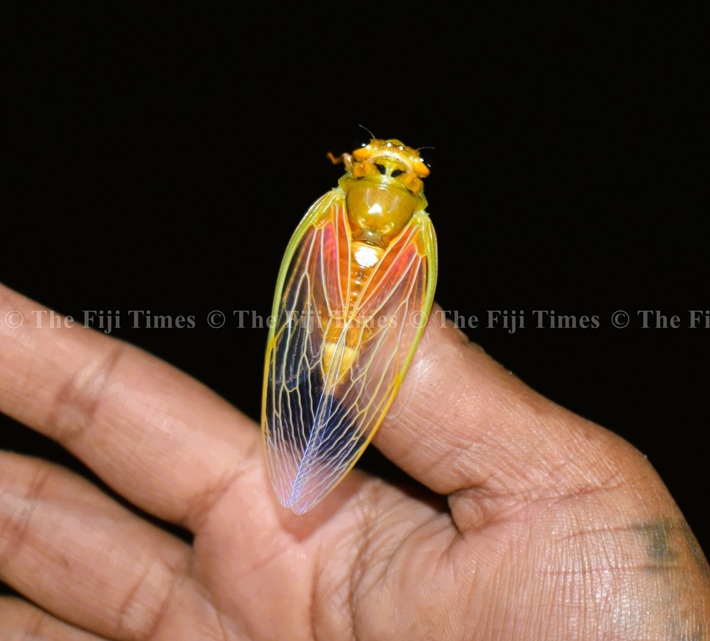The story goes that long ago, two warring chiefs from the hills of Viti Levu came together to end a bitter dispute over land. Beside a stream in Navosa, Cabeta of the Burenitu clan and Lewatu ni Bovitu of the Emalu clan argued, then finally agreed that the Nadoi creek, a tributary of the Sigatoka River, would be their boundary. To seal the pact, they exchanged gifts. Lewatu ni Bovitu presented prawns, declaring that they would forever fill the waters of Cabeta’s land. Cabeta in return handed over a small cicada, promising that it would appear on Lewatu ni Bovitu’s land once every eight years, in great numbers, to feed his people. From that day, the freshwater shrimp became the totem of the Burenitu clan in Serua, while the cicada – the nanai – became the sacred emblem of the Emalu clan in Navosa. Lewatu ni Bovitu is said to have released the insect at his bathing pool, Nubu ni nanai, where its descendants still emerge in cycles, singing loudly before vanishing as suddenly as they came. So significant was the exchange that chiefly daughters of the Emalu people, descendants of Lewatu ni Bovitu, carry the rare chiefly title Rokonai, a living reminder of the covenant tied to the Nanai.
A rare forest dweller
The nanai, known scientifically as Raiateana knowlesi, is more than myth. It is a biological wonder unique not only to Fiji but to the entire southern hemisphere. Found only in the mountainous provinces of Navosa, Namosi and Serua, this cicada spends most of its life hidden underground. For eight years, its nymphs quietly draw sustenance from plant roots before surfacing in spectacular fashion. When the time comes, the nymphs crawl out of the soil, shed their hard casings, and transform into winged adults, their bodies marked with black lines and rusty-red tinges at the base of their transparent wings. The adult stage is fleeting – just a few weeks – yet in that short span the forests echo with their sharp, unmistakable calls. Males sing to attract mates, females lay eggs in tree branches, and then both die, leaving their young to burrow into the earth until the cycle repeats. This rhythm of emergence is unlike that of any of Fiji’s 18 other cicada species, making the nanai a biological marvel.
A cultural treasure
For the people of yavusa Emalu, the nanai – or Lewatu ni Bovitu, as they call it – is far more than an insect. It is a totem, an omen of good fortune, and a symbol of prosperity that guides their planting, harvesting, and ceremonies. Its deep cultural resonance explains why the nanai is immortalised on Fiji’s $100 banknote, among the flora and fauna that celebrate the nation’s biodiversity. To many, it stands as a crown jewel of the forests and a reminder of abundance.
A fragile future
Yet, despite its cultural importance, much about the nanai remains unknown. ScientiFFsts say there has been little detailed research on its ecology or behaviour. Unlike the periodical cicadas of North America, which have been extensively studied, the nanai’s long life cycle and remote forest habitat make it difficult to observe. What is known raises concerns. Introduced predators such as pigs, mongoose, rats and cats prey on its underground nymphs. Human activities including logging, mining, forest fires and development projects threaten its delicate habitats. In some areas, people collect the cicadas as food, adding further pressure. The species is not yet listed on the IUCN Red List of threatened species, but conservationists warn that the lack of data is troubling. Without urgent research and protection, Fiji could lose this rare natural treasure before its value is fully understood.
Value the unseen
For indigenous Fijians, especially those of Navosa, Namosi and Serua, the nanai is more than a curiosity. It embodies a worldview where nature, culture and prosperity are inseparably linked. The cicada’s eight-year rhythm is a reminder that abundance must be nurtured if it is to endure. Its song is both a celebration and a warning – that the smallest of creatures can hold the greatest of meanings, and that what is unseen should not be forgotten. Just as the chiefs once exchanged gifts to make peace, the nanai remains a gift to Fiji – a symbol of promise, identity, and the fragile harmony between people and the land. The myth of the nanai was adapted from the book ‘Mai Veikau – Tales of Fijian Wildlife by Dick Watling’.
- History being the subject it is, a group’s version of events may not be the same as that held by another group. When publishing one account, it is not our intention to cause division or to disrespect other oral traditions. Those with a different version can contact us so we can publish your account of history too — Editor.



